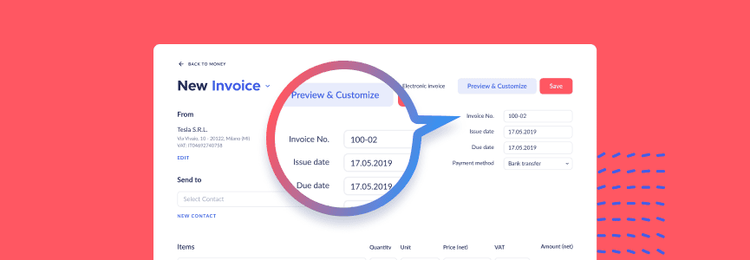It’s vital for an entrepreneur to know how to write an invoice properly, no matter if they have already created invoices in the past or are about to issue their first. When writing an invoice, one should keep in mind that missing even a single section may lead to unfortunate consequences. No one wants to look unprofessional in front of their customers, so it’s better to take some time for proper preparation and learn more about the role of each invoice section.
Writing invoices can be pretty time-consuming and monotonous; still, it’s an essential part of your business journey that can’t be skipped. Below, you will find comprehensive information that clarifies what invoices are and why you need to fill them out correctly on the first try.
Finom tips: How to create an invoice with Finom?
What Is an Invoice?
An invoice is a bill that a vendor sends to a customer upon completion of an order. Invoices generally contain information such as a description of services or goods your business provides, the cost of these services or products, payment terms, and execution time. Though today invoices are mainly sent and processed online, they can still be delivered in person.
From a legal point of view, an invoice creates an account receivable; thus, it’s considered a legally binding request for payment. Once the services are rendered, or the products are delivered, the client who received the respective invoice has to pay it on time, as determined by the payment terms.
Invoices help build healthy record keeping, as vendors usually use them to keep track of sales and store information on income for tax and accounting purposes.
It’s important to understand that invoices are not the same as receipts (the financial documents acknowledging payment) or POs (purchase orders), which are used to notify a provider about a customer’s intent to buy products and services. You can learn more about the major differences between an invoice and a purchase order here.
The most common, quickest, and easiest way to send the invoices is via email. Create and send invoices in a read-only PDF format in order to prevent potential fraud. Don't forget to add a clear description of your company while attaching the invoice, so your client can understand what kind of financial document they received. This information is usually included both in the subject and body of the email.
Finom tips: How to personalize your invoice with Finom?
How to Fill Out an Invoice Properly?
Your customers must be aware that they have received an invoice, not just a random document. Statistics say that simply adding the word “invoice” to the heading of your document or email subject makes the bill stand out from other financial documents. Therefore, it increases the chances that the client will pay the invoice on time.
You should make every reasonable effort to create professional invoices that can help you build trust with your customers. Don’t forget about the stylistic layout of your invoice: you can try to do it yourself or use an invoice generator that will create memorable, professional-looking documents and automatically send the invoices to the clients.
While the word “invoice” in the heading is good to have, it is not mandatory, yet some things must be included on an invoice for it to be considered a legally binding document.
Business Name
One of the key elements an official invoice template must include is the name of your business. Not only does it make clear to the customer who you are, but it also defines your brand and improves the overall image of your company.
Your business name should be in a large font, using the company's corporate colors, and be displayed at the top of the document (either centered or left-aligned).
Tip: A well-designed logo can add an extra professional touch to the official documents issued by your company. With an attractive business logo added to your invoice, you are three times more likely to get paid faster.
Contact Information
Your clients should be able to contact you if there is any disambiguation or they have questions regarding your products, services, or the invoice itself. What’s more important, seller contact information enables your customers to contact you for future cooperation.
General rules imply that you should include the contact details, such as your business address, email address, and phone number, right below the business name. The contact information should be in a smaller font than the one used for the business name, but customers should still be able to find your contact details easily.
Invoice ID
To make things significantly more manageable for the upcoming tax season, it’s obligatory to keep invoice tracking organized by providing a unique identification number for every document. It is best if you make sure each invoice has a unique ID (identification number); otherwise, you won’t be able to prevent the issuance of duplicates. Invoice numbers can be generated using a sequence of gradually increasing numbers; sometimes, business owners also add letters in front of the row of numbers to indicate a specific customer.
Tip: Use the invoice service of Finom, to store the information about your company and customers and generate the identification numbers for your invoices automatically. No need to worry about filling in IDs or other important details incorrectly!
Payment Terms
The type of payment terms a small business can use depends on many factors, such as standard practices specific to your industry, your current relationship with the customer, and your cash flow consistency. For instance, “NET 60” implies that the invoice is due 60 days after the invoice was issued. Take into consideration that some clients may pay later than the set due date. Avoiding a cash-flow gap becomes possible if you account for a little extra time beforehand, e.g., using “NET 60” payment terms instead of “NET 30”.
The payment terms are probably the most critical information present on your invoice. They must be clear, simple, and arranged well in advance. Even though payment terms are generally agreed-upon, it’s a common courtesy to include them on the invoice, along with the available payment methods. If you want the client to make the payment via a bank transfer, make sure you’ve added bank details to encourage a quicker payment. Such a technique is a sign of good customer service that enables you to avoid possible invoice disputes in the future.
Due Date
The due date is calculated by adding the payment term days to the date of the invoice issuance. This part of the invoice should be written in simple English to make it as easy to understand as possible. Adding a due date to your invoice makes you look tactful and professional in the eyes of the customer, as they have a clear understanding of when they have to pay. Another good decision is to set up payment reminders for your clients, so they can stay updated and refer to the payment schedule any time they need.
Customer’s Contact Details
Specify whom the invoice is created for, and don’t forget to include the customer's contact information. The utmost prudence in this endeavor will come in handy when you need to find the client's contact details quickly. Ensure the invoice reaches the right person by including the recipient’s name, business, and email address. You should also add a service address if it differs from the mailing address.
Product or Services Details
The more information on the products or services your invoice contains, the better it is for your business. This is what most vendors usually include on an invoice:
- Product description
- The quantity of the goods
- Payment rate
- The exact and subtotal amount
Each line item should contain a description of the services and their associated cost. It doesn’t matter how many details you add; the main goal is to provide the client with extreme transparency on what they’re paying for. Therefore, you minimize the possibility that the customer will have additional questions that may delay the billing process.
Sales Tax
The tax requirements vary in accordance with the type of business you run and your jurisdiction. In order to specify the correct tax amount on the invoice, you should refer to the local tax bureau for relevant information.
Tip: Using special invoice software can substantially simplify the management of your business activities. Try the Finom invoicing service to make your tax season easier. It enables you to adjust the tax settings when needed and quickly match invoices with incoming payments to create relevant tax reports.
Discount Information
When offering a discount to a valued or regular customer, include it in the invoice. It can be either a percentage or an exact amount; in any case, it should be displayed right above the total amount owed. Thus, your clients will see how much they must pay and which benefits they get when ordering goods and services from you.
Personal Notes
A personalized note can be a powerful tool to help providers leave a great impression on the customer and increase the chances that the invoices will be paid faster. This section can also contain payment instructions (if you haven’t specified them in the payment terms), warranties (e.g., money-back guarantees), and other details relevant to the order. Notes are usually located at the bottom of the bill.
Finom tips: How to download an invoice with Finom?
How to Create a VAT Invoice?
If your business is VAT-registered, you should use VAT invoices. This type of invoice requires more information than regular ones.
VAT (Value-Added Tax) is a general consumption tax imposed on the value added to products and services in the European Union. This type of tax applies to practically all products and services bought or sold for the purposes of consumption in the EU. However, it’s essential to know that products, goods, and services sold to clients abroad are not subject to value-added tax.
What Determines a Value-Added Tax?
- It’s a general tax applied to most commercial production of goods and the delivery of services.
- It’s a consumption tax because it is charged not on the business entity but the final consumer.
- It’s assessed as a certain percentage of the product’s price, meaning that the customer is always aware of the actual tax amount.
- It's an indirect tax, as a purchaser pays it as a part of the product's price, but it's collected by a vendor only to be later transferred to the tax authorities.
VAT rates in the United Kingdom are pretty simple and always charged the same throughout the territory of the country:
- Standard rate: 20% for most products and services
- Reduced rate: 5% for some products and services (e.g., some children’s goods, electricity, and tobacco cessation products)
- Zero rate: 0% for some products and services (e.g., most food items and beverages).
If you are a UK resident, there are three types of VAT invoices you can issue as a business owner:
- Full invoice
- Modified invoice (if the cost of your retail supplies is over £250)
- Simplified invoice (if the cost of your retail supplies is under £250).
Therefore, the information business owners need to include on their VAT invoices depends on the type of invoice issued. Still, every VAT invoice should contain the same information as a standard invoice and some additional data, which includes:
- VAT registration number
- Tax point and the time of supply if it differs from the invoice date
- VAT rate (if line items are charged at different VAT rates)
- Total VAT charged (if all line items are charged at one and the same VAT rate).
How to Choose Invoice Software?
The invoicing process can be quite overwhelming, as business owners have to bear many important things in mind, and every mistake comes with a heavy price tag. You can make an invoice yourself, but various invoicing tools can take the stress out of your attempts to create an invoice from scratch.
Invoice generators suggest different invoice templates, and some financial services, like Finom, even enable medium and small businesses to create, send and chase invoices, thus freeing them of tedious record-keeping. If you still have doubts about which invoice software is tailored precisely to your needs, checking out the reviews left by other customers can be an intelligent choice.
Takeaway
Different enterprises and clients might follow different processes for sending or receiving invoices. However, it's always a good idea to specify certain information (such as your business name and payment due date) in the subject line of your email to get paid faster.
Sometimes vendors call their customers upon sending an invoice just to make sure the client has received it. A phone call can also be used as a means of nudging if the payment hasn’t been sent for a while and the deadline has already been missed.
There is no need to reach out to your customers directly if you use special invoicing software. In this case, the system will automatically notify your clients about the due dates, deadlines, payment amount, etc. Moreover, you can use the invoicing software to schedule and send reminders if a payment is overdue.
Last articles

Finom Raises €50M in Series B Funding Led by General Catalyst and Northzone

Passkeys: Powering Finom’s Security Upgrade

Pro Forma Invoice: What It Is and Its Meaning

PO vs. Invoice: What Are the Differences Between These Financial Terms?

Invoice Number: What Is It and Why Should I Generate One?

CVV Code: The Guardian of Your Financial Security

What Are the Best Business Name Generators for Naming Your Business?
Share post
